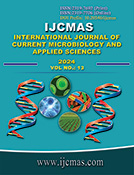


 National Academy of Agricultural Sciences (NAAS)
National Academy of Agricultural Sciences (NAAS)

|
PRINT ISSN : 2319-7692
Online ISSN : 2319-7706 Issues : 12 per year Publisher : Excellent Publishers Email : editorijcmas@gmail.com / submit@ijcmas.com Editor-in-chief: Dr.M.Prakash Index Copernicus ICV 2018: 95.39 NAAS RATING 2020: 5.38 |
Vegetable producers on the Bapla site use a wide range of methods to manage pests on vegetable crops; however, chemical fertilisers and pesticides are used almost systematically, despite the harmful effects of these chemicals on the environment and climate change, and on the health of producers and consumers. The phytosanitary analysis carried out in this study on this production perimeter aims to take an overview of the current practices in terms of the protection of vegetable crops, with a view to adopting good practices in the protection of the crops grown there. A sample of 50 growers was surveyed using a survey questionnaire prepared with Sphinx software. The study revealed that 98% of the growers surveyed systematically use chemical pesticides to protect their produce, although 96% are aware of the toxicity of these products. Some growers use plant extracts as biopesticides from time to time. The survey reveals that only 02% use biopesticides as an alternative to chemical pesticides. 75% of the vegetable growers surveyed were aware of biopesticides, compared with 25% who were unaware of their existence. As for the effectiveness of biopesticides, 77% of those who were aware of their existence and had already used them said they were effective. The study reveals that the availability of biopesticides and the time and effort required to formulate them are constraints on their use. 72.09% of growers advocate the availability of effective biopesticides at affordable prices. At the end of this study, it emerged, firstly, that there is an urgent need for ongoing training and retraining for farmers in the rational use of chemical pesticides, and secondly, that farmers need to be made aware of the need to promote the integrated management of crop pests. This will be done by building capacity in the formulation of biopesticides effective against pests and in the application techniques for these plant protection products.
Adekambi S. A., Adegbola P. Y. & Arouna A., 2010. Perception paysanne et adoption des biopesticides et/ou extraits botaniques en production maraichère au Bénin. In: Contributed Paper Presented at the Joint 3rd African Association of Agricultural Economists (AAAE) and 48th Agricultural Economists Association of South Africa (AEASA) Conference, September 19-23, Cape Town, South Africa. https://doi.org/10.22004/ag.econ.95917
Adeoti R., 2014. Caractéristiques des exploitations maraîchères au Bénin et au Burkina Faso, deux pays de l’UEMOA. Bulletin de la Recherche Agronomique du Bénin (BRAB) Numéro spécial Economie et Sociologie. En ligne sur
Agboyi, L. K., G. K. Ketoh, T. Martin, I. A. Glitho And M. Tamo, 2016. Pesticide résistance in Plutella xylostella (Lépidoptère : Plutellidae) populations from Togo and Benin International Journal of Tropical Insect Science -1(04):1-7 https://doi.org/10.1017/S1742758416000138
Best Consult/Bera, 2010. Programme régional de développement durable de l’agriculture irriguée dans la région du sud-ouest. Rapport diagnostic, 123p
Fotio D. & Temwa A., 2012. Les biopesticides de plus en plus préconisés mais peu utilisés en agriculture de l’Afrique de l’Ouest et du Centre, http://www.cpac-cemac.org/article_fr.php?IDActu=209,(20/09/2017)
Kanda, L., S. Akpavi, K. Wala G. D. Boundjou and K. Akpagana, 2014. Diversité des espèces cultivées et contraintes à la production en agriculture maraichère au Togo. Int. J. Biol. Chem. Sci. 8(1): 115-127 https://doi.org/10.4314/ijbcs.v8i1.11
Mah, 2011. Rapport général du module maraîchage. Ministère de l’Agriculture et de l’Hydraulique, Ouagadougou, Burkina Faso, 318 p.
Malo 2021, Rapport des activités de conseil agricole sur le site de Bapla. (Cultures de contre saison) 19p.
Mondedji, A.D., Nyamador, W.S., Amevoin, K., AdéotI, R., Abbey G.A., Ketoh G.K. and Glitho, I.A. (2015) Analyse de quelques aspects du système de production légumière et perception des producteurs de l’utilisation d’extraits botaniques dans la gestion des insectes ravageurs des cultures maraichères au Sud du Togo. International Journal of Biological and Chemical Sciences, 9, 98-107. https://doi.org/10.4314/ijbcs.v9i1.10
Ouedraogo R. A., 2011. Biologie, écologie et efficacité des extraits végétaux contre Phoma sorghina (Sacc.)
Ouedraogo, R. A., Pooda, L., Kambire, F. C., & Kone, M. (2020). Risques de pollution environnementale par l’utilisation des pesticides en maraîchage : cas des exploitations de Sakaby et de Dogona à Bobo-Dioulasso. Sciences Naturelles Et Appliquées, 39(2(1), 11.
PDCLF, 2017. Rapport de situation de référence: Phase finale 2018-2022 Projet de Développement des Cultures Fruitières et des Légumes. Burkina Faso, 96p.
Pooda L. 2017. Pratiques maraichères et risques de pollution environnementale par les pesticides : cas de quelques exploitations de Sakady et de Dogona à Bobo-Dioulasso. 40-59P.
Son D., Somda I., Legreve A. Et Schiffers B., 2017. Pratiques phytosanitaires des producteurs de tomates du Burkina Faso et risques pour la santé et l’environnement. Cah. Agric. 2017, 26, 25005. https://doi.org/10.1051/cagri/2017010
Yarou Boni Barthélémy, Assogba Komlan Françoise, Tossou Eric, Mensah Armel, Simon Serge, Verhaegen Daniel, Francis François. 2017. Efficacy of basil-cabbage intercropping to control insect pests in Benin, West Africa. Communications in Agricultural and Applied Biological Sciences, 82 (2) : pp. 157-166.
Yovo K., 2010. Consentement à payer les biopesticides : une enquête auprès des maraîchers du littoral au sud-Togo. Tropicultura, 2010, 28, 2, 101-106.
 |
 |
 |
 |
 |